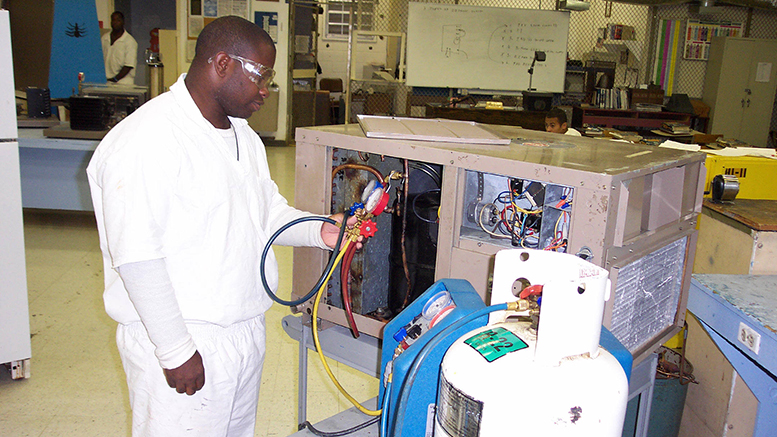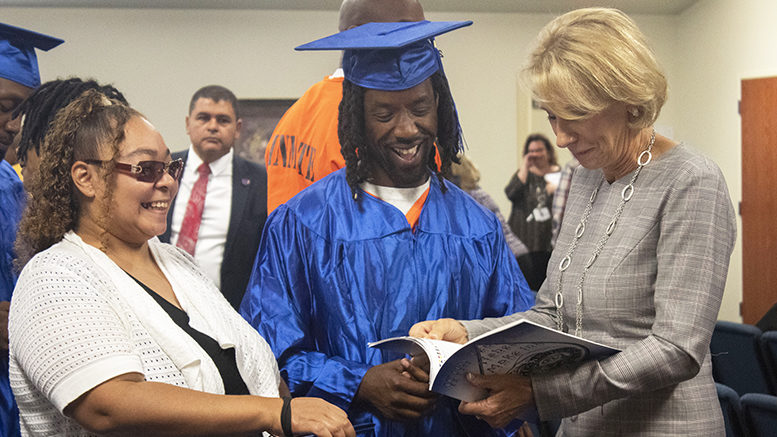Community colleges with educational programs at correctional facilities have had to deal with some extra challenges serving students during the COVID-19 pandemic.
Prisons don’t generally give inmates access to the internet, and many have become COVID hotspots. That is causing major disruptions in colleges participating in the U.S. Education Department’s Second Chance Pell pilot program.
Due to the pandemic, Chaffey College has transferred its inmate education to a correspondence model for the spring and summer. The college serves about 250 inmates at two state prisons. It’s been providing education at the California Institution for Women since 2005 and the California Institution for Men since 2015.
“We tried to replicate the experience any Chaffey student would have,” says Rob Rundquist, interim dean of institutional effectiveness and intersegmental partnerships.
Faculty taught classes in person. Inmates had access to computers at tutoring centers. But then there were coronavirus outbreaks at both prisons and visitors subsequently were prohibited. Inmates’ movements were restricted, and many could no longer get access to computer labs.
A different model
Under the correspondence model, faculty create packets with instructional materials, exams, projects and homework. Students complete the work at their own pace, in their cell or a classroom.
“It’s been challenging,” Rundquist says, but “the really challenging part is support services.”
College librarians collect resources to help students do research. They include a variety of source materials, requiring students to determine which ones are most credible. Chaffey plans to continue the correspondence approach in the fall.
Transforming lives
Like many colleges, Chaffey supplements its Second Chance Pell funds with other resources, which allows it to serve more inmates.
“No one is more dedicated to transforming their lives,” Rundquist says of the inmate students. “These programs are highly successful,” he notes, adding that each dollar spent on education in prisons saves $5 on reduced recidivism.
Related article: ED expands Second Chance Pell pilot program
Many of the graduates have developed a lifelong connection to Chaffey, Rundquist says.
“These students are very dedicated. They take everything they receive from college not only to benefit their own lives but to benefit their community,” he says.
Life after prison
One of the biggest challenges they face is the lack of job opportunities for people with a prison record. One exception is in distribution, a major industry in Southern California’s Inland Empire. Some graduates have landed jobs in transportation, logistics and warehousing, Rundquist says. Others are working for nonprofits and support networks for “justice-impacted individuals.”
One former inmate of the California Institution for Women now works as an advocate urging Congress to lift the ban on allowing eligible incarcerated students in any state or federal prison to access Pell grants. (Second Chance Pell is restricted to participating colleges.)
The American Association of Community Colleges and other higher education and justice reform advocates support recently House-passed legislation that would restore such eligibility for eligible inmates.
Classes suspended
“When COVID hit, we put anything face-to-face on pause,” says Pete Selden, vice president of workforce development at Tulsa Community College (TCC) in Oklahoma.
TCC had to suspend its Second Chance Pell program at the Dick Conner Correctional Center. Visitors were banned and inmates were not allowed to have internet access. Inmates who enrolled in the spring received incompletes. Selden hopes they can finish the classes in the fall.
He is confident the prison will find a way to provide limited internet access for the students. If that happens, the fall semester will be reduced from 16 to eight weeks. New students won’t be admitted because of the challenge of teaching online.
Under the college’s partnership with the prison, TCC faculty deliver classes leading to an associate of arts degree in liberal arts, an associate of applied science degree in business focusing on entrepreneurship, and a certificate in horticulture.
TCC partners with Langston University, a historically black institution, that offers a pathway to a bachelor’s degree to inmates at Dick Conner.
Last summer, 70 inmates graduated from the program, the most since it started in 2007.
Workforce training continues
Lee College in Texas has continued to send faculty inside correctional facilities to teach career and technical courses unless the facility shuts down due to a coronavirus outbreak.
“It’s pretty disruptive, but at least we’re getting to see the students,” says Donna Zuniga, dean of Lee’s Huntsville Center, which oversees the Second Chance Pell program.

Lee also uses a correspondence approach for its academic classes during the pandemic. Students receive a packet of materials and have two weeks to complete their assignments.
The inmates have access to email through the JPay service. They also can use the prisons’ computer labs, with limited online access through an intranet that allows them to carry out research for their classes.
Since visitors are not allowed, inmates haven’t seen their families since March.
“They are very grateful the college is going above and beyond to bring them college courses,” Zuniga says. “Their only connection to the outside world is through the college instructors.”
Sustaining momentum
For the fall, Zuniga hopes to provide online capability on a pilot basis so inmates so can use LaunchPad and Blackboard and use a chat function to communicate with their instructors. When a unit is designated COVID-free, in-person classes are expected to resume.
Despite the interruptions, students have been able to complete their courses and graduate on time, Zuniga says.
“They’re even more motivated to work with us during the pandemic,” she says.
Lee has had a presence in the prison system since 1965, Zuniga notes. The college serves about 1,200 to 1,500 students per semester at eight correctional facilities.
The prisons have vocational training areas, with trucks for teaching commercial driving, welding shops and other instructional labs. A maximum-security prison, a women’s prison and a facility for young offenders have horticulture programs.
Switching gears
Jackson College in Michigan also converted its face-to-face inmate education program to a form of distance learning during the pandemic.
“That has definitely been a challenge,” says Bobby Beauchamp, director of the college’s corrections education program, which provides its services at the Federal Correctional Institution in Milan and seven state prisons.
Jackson had been generally educating about 700 inmates per semester, but that dropped to 560 for the spring/summer term as many students in the program were released early on parole due to the pandemic, Beauchamp says. In other cases, inmates stopped out if they weren’t comfortable with distance education.
Without face-to-face classes or internet access, the college had to carry out more complex procedures for educating inmates. Instructors now record lectures, and information technology staff installs them on a laptop for each prison. One prison allows nine inmates in a room to watch a prerecorded lecture. In other facilities, prison staff plays the lectures on a closed-circuit TV in each inmate’s cell or cubicle.
Leaning in technology
Jackson also provides a packet of materials – books, course handouts, paper and pens – for each student inmate. Corrections officers have to inspect them for contraband and make sure they are distributed to the right student.
The Second Chance Pell grant covers the cost of the laptops and instructional materials, costing about $3,100 per student per semester.
The college pays for a JPay email account for each inmate so they can correspond with their instructors. If a student needs to do research, they can submit a request form to the Jackson College library.
“We’ve gotten mixed reviews from students,” Beauchamp says. “Some are frustrated with online learning, but a lot of inmates are extremely understanding and thankful they can continue their education.”
Success stories
College leaders are proud of their success. Chris Avirett, an alum of Lee’s Huntsville Center, founded the Elite Comfort air conditioning company in Houston and hires other former inmates, Zuniga notes.
Another alum, Brandon Warren, who was incarcerated three times since he was 16 years old for robbery and drug offenses, earned a bachelor’s and master’s degree upon release. He is working on a doctorate from the University of St. Thomas in Houston.
In 2017, Zuniga hired Warren to work for the Huntsville Center, where he helps inmates prepare for release, transition to life outside, and find jobs and housing. He serves as an adjunct instructor in philosophy for the inmate program and established an alumni organization.
Ramsey Fakhouri earned an associate degree while serving eight years at the federal prison in Milan, Michigan, says Beauchamp. After his release, he was elected an officer in the Phi Theta Kappa International Honor Society and received a full-ride scholarship to the University of Michigan at Ann Arbor.
Jequillian Chandler, who served 18 years for armed robbery, completed an associate degree from Jackson College at the Cooper Street Correctional Facility in 2015 and also earned a scholarship to the University of Michigan.
Brian Jones earned 24 credits from Jackson. Upon his release, he earned an associate degree at Oakland Community College, transferred to Eastern Michigan University and then opened his own clothing business in Detroit.
Jones returned to Cooper Street as a graduation speaker, and he and Chandler went to Washington, D.C., to urge Congress to expand Second Chance Pell.
“It’s a proven program,” Beauchamp says. “It has an awesome impact not only on our students, but on their families, the community and the state as a whole.”
“The most beneficial part,” he adds, “is seeing our students released and going home to make the most of their education and setting themselves up for success.”

